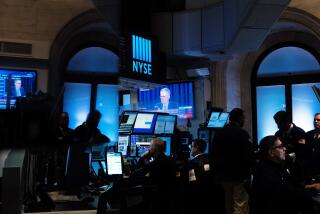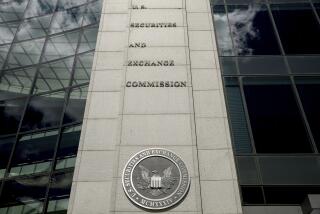Markets and Modems
- Share via
It’s one of the hottest trends to hit individual investing in two decades: online trading, in which you can use your personal computer to trade stocks and mutual funds.
Limited forms of online trading have been around for more than 10 years, but they appealed only to a narrow segment of investors. Now, thanks to the widespread growth of the Internet and its World Wide Web, trading stocks in cyberspace is becoming routine in a rapidly growing number of U.S. households.
“I’m not a computer whiz kid, and it’s really easy to use,” said Tom Juenger, 24, a financial services researcher in Venice who’s been trading online for a year.
The number of online brokerage accounts currently exceeds 650,000, a 50% increase since 1994, according to the consulting firm Forrester Research Inc. in Cambridge, Mass. Forrester predicts the number will soar to 1.3 million by 1998.
One fledgling provider of low-cost online trading, E-Trade Securities Inc., is now handling between 8,000 and 10,000 trades per day, more than double its level of six months ago.
To be sure, all of the online activity is still a pittance compared with the volume handled by traditional means, which in recent weeks has topped a combined 800,000 trades per day on the major exchanges and the Nasdaq market.
Online trading also is limited mostly to the discount brokers. The giant full-service firms, such as Merrill Lynch & Co., offer information and data on the Web. But they don’t yet offer online trading, because it would preclude the need for the human brokers that are the backbone of the firms’ retail operations.
Some firms and investors worry about security--namely, that a hacker could somehow get into personal accounts or otherwise disrupt trades. But those already handling online trades, such as discount brokerage leader Charles Schwab & Co., maintain that no online trading account has yet been breached.
Besides, “you read about brokers getting in trouble every day,” Juenger said.
Be advised, though, that some online brokers have suffered glitches on heavy trading days, just as soaring volume has plagued conventional brokers. Online investors have complained that on such occasions, there have been delays in getting accurate prices and in getting their trades executed.
Nevertheless, most experts believe online trading will become as permanent a part of the investment landscape as discount brokers, which took off 21 years ago when trading commissions were deregulated.
“This will be far more than just another tool” for investing, said Art Shaw, Schwab senior vice president for electronic brokerage.
Online trading, in fact, is another step in the evolution of discount brokerage. As with most others who use discount brokers, PC traders buy and sell based largely on their own assumptions and without much assistance from a stockbroker.
Also, online trading takes price discounting even further. Commissions on trades of, say, 100 shares of a $50 stock have been slashed as low as $12 in some cases, because Schwab, E-Trade, Quick & Reilly and others are aggressively vying for the burgeoning online business.
That compares with full-service commissions on a similar trade of $70 or more, and conventional discount-brokerage commissions of $30 and higher. (Keep in mind that rates vary widely among brokers, however.)
Joe Ricketts, chief executive of TransTerra Co., an Omaha-based parent of four small online-trading brokers including eBroker, sees a day within six years when “the Internet will bring the telephone and the PC and the TV into one implement.”
“It will deliver all the information they [investors] need, and it will be simple and easy to use,” he said.
Some firms are also exploring the idea of using the Web to one day handle exclusive Internet trading in which buyers and sellers would bypass the traditional markets to trade securities directly.
So, what if you want to join the bandwagon? How exactly does online trading work, and how does it differ from the conventional method of using a human broker?
For starters, it helps to think of online trading this way: It’s not much different from picking up the telephone and voicing your trade to a broker on the other end. But instead of the broker taking your voice order and punching it into a computer, you do that directly. And it’s that increased efficiency in the trading process--eliminating the human intermediary--that enables firms to offer lower commissions for online trades.
There are three main ways to trade using a PC: using specialized software provided by brokerage firms, such as Schwab’s StreetSmart; by accessing an online service, such as America Online or CompuServe; or by using the Web.
The software packages are often included with new brokerage customer accounts that require minimum opening balances of $1,000 or more. (The online services will of course charge a fee for their connection, which will be in addition to whatever trading commissions you will pay.)
To get the Web-based brokerages, experts say, you’ll need a PC that can access the Web and run such Internet “browsers” as Netscape Navigator or Microsoft’s Internet Explorer. You’ll also need at least a 14,400-baud modem.
OK: You’re a customer in good standing with one of the brokers, you’ve got the PC gear and you’re ready to trade. Now what happens?
Let’s suppose you want to buy 100 shares of General Electric Co., listed on the New York Stock Exchange, at the market price. And you want to do so via the Web.
You would access your broker’s Web site, which would give you directions for listing the order and sending it in. (Many of the brokers also provide clients with information about their accounts, current stock prices and so forth, often at no additional cost.)
The order goes electronically to the broker’s host, or processing, computer, which in turn relays the order to the NYSE--all at blinding speed.
At firms such as Schwab, which are constantly taking both phone and PC orders, the host computer discerns no difference.
“It’s handled exactly the way any other trade goes through,” Shaw said.
Most individual orders will be sent automatically to the NYSE via the exchange’s SuperDot computer system. It routes trades of up to 30,099 shares directly to the “specialist”--in this case, GE--who makes the market in that stock on the Big Board’s floor.
To use Schwab as an example, if the order is larger, it is sent to Schwab’s floor broker at the NYSE, who personally takes it to the specialist’s post to find the best price among buyers and sellers standing nearby.
As soon as the trade is completed, confirmation of the purchase is relayed back to the investor’s PC monitor, typically in less than a minute.
What if markets are closed? A PC user can enter an order at any time and have it executed when the markets open the next trading day.
Depending on which broker you use, you can also sell stock, sell stock short, trade stock options, buy and sell mutual funds and trade bonds.
What’s the NYSE’s position on online trading?
Well, Big Board officials are careful to avoid using that term, because to them it implies that trades are actually being completed online and away from the exchange floor--which, of course, they are not.
But “we’re interested in all developments in the markets,” said NYSE spokesman Andrew Yemma. “In a sense, the Internet has the same function as a telephone in the routing of orders right now.”
Which raises a question: Given the relative ease of trading by telephone, why shouldn’t PC users just pick up the phone to trade?
Mainly because it costs less to trade by computer, and it offers a discount that appeals to the growing number of investors now at ease with their PCs.
“Two-thirds of our client base owns a home PC,” said Schwab spokesman Tom Taggart. “They’ve grown up with the technology and feel more comfortable with it. So they don’t mind using alternative channels to conduct their business.”
(BEGIN TEXT OF INFOBOX / INFOGRAPHIC)
How Online Trading Works
More than 600,000 people now use their personal computers to trade stocks, and the number is growing rapidly. Here’s a typical trade using a hypothetical customer of broker Charles Schwab & Co. who wants to buy a New York Stock Exchange-listed stock.
1. The investor punches in an order to buy 100 shares of IBM, using Schwab’s online trading software or its World Wide Web site on the Internet, or going through another gateway such as America Online.
2. The order is immediately routed to Schwab’s host computer in San Francisco, which in turn electronically forwards it to the NYSE.
3. If the order involves fewer than 30,000 shares, it’s entered via the NYSE’s automated Super Dot system, which moves the order directly to the IBM specialist on the exchange floor. The specialist seeks the best price among buyers and sellers standing nearby and completes the trade.
4. If the order involves more shares, it’s routed to Schwab’s floor broker at the NYSE, who takes it to the specialist’s post, seeks the best price and then has the specialist complete the trade.
5. In less than a minute, Schwab confirms that the trade has occurred and at what price, then electronically relays the information back to the investor’s PC.
(BEGIN TEXT OF INFOBOX / INFOGRAPHIC)
Online Accounts
Number of investor accounts through which securities are traded via personal computer.
1994: 400,000
1995: 600,000
1996: 800,000
1997*: 1,000,000
1998*: 1,300,000
* Projected
Sources: New York Stock Exchange; Charles Schwab; Forrester Research
More to Read
Inside the business of entertainment
The Wide Shot brings you news, analysis and insights on everything from streaming wars to production — and what it all means for the future.
You may occasionally receive promotional content from the Los Angeles Times.











